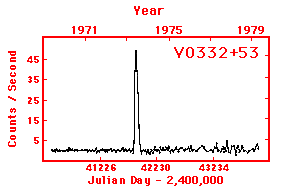X-ray Transients

|
This is an X-ray image of a ROSAT PSPC observation of a portion of M31.
The source shown in the circle is RX J0045.4+4154, a recently discovered
recurrent X-ray transient.
|
A rocket-borne experiment in April 1967 found an intense X-ray source in
Centaurus. This source had not been detected a year or so before, and
observations after April showed a steady decline in the source luminosity
until it completely disappeared in late September. The source was named
Centaurus X-2, and the word "transient" was associated with its
behavior. Two years later, in 1969, another source was seen in the Vela 5B
satellite data which exhibited similar "not there, then there, then not
there" behavior. By mid-1973 enough sources had been discovered with
similar characteristics, that a new class of sources, the X-ray transients,
was firmly entrenched in X-ray astronomy.
The precise definition of an X-ray transient has undergone significant
evolution since the early 1970s, primarily because of ever-increasing
sensitivity of X-ray telescopes and detectors. Originally, the definition was highly
observation-biased, e.g., a transient had to have a rapid rise time
(< 1 week) and gradual decline (~ 1 - 8 weeks), the maximum to minimum
X-ray flux ratio had to be of order 1000, the source could not reappear on
time scales less than 2 years, and so on. Today, the definition is much less
restrictive. Today, a source is defined as a transient if it has periods of
enhanced X-ray emission which typically last longer than a week, but which are
not representative of the usual observed emission from the source. Recurrences
can be periodic or aperiodic, but there is no obvious correlation between
recurrence time and the luminosity amplitude of the outburst.

|
The ten-year light curve of the transient source V0332+53 as seen by the
Vela 5B all-sky monitor. The source became very bright in 1973, and was
not seen again until 1983.
|
X-ray transients seem to divide themselves naturally into 2 classes: those
associated with High Mass X-ray Binaries and those associated with Low
Mass X-ray Binaries. The High Mass X-ray Binaries
contain a
neutron star or
black hole paired with a
massive star (usually more than 5 times the mass of our sun). Often
the stellar companion is a Be star, which sometimes sheds material
from its equatorial region. In
these systems, the transient event is characterized by having
more higher energy x-rays in the spectrum. The Low Mass X-ray Binaries contain a
neutron star or black hole orbiting around a cooler, low mass star.
These transient events often generate more lower energy x-rays.
How Do They Do It?
It is believed that sudden profound changes in the the accretion rate of
the neutron star (or black hole) in the binary system lies at the heart of
the transient behavior. The question, then, is WHY the sudden change. For
some stars, we have fairly conclusive evidence of the reasons... for others,
we are not yet sure.
For a binary to be a bright X-ray emitter, there has to be some source of
material which the neutron star can accrete. In High Mass X-ray
Binaries, a companion Be star provides a
well-known potential source of the material for the neutron star. Be stars are known to possess a circumstellar envelope which is
strongly concentrated in the equatorial plane. Furthermore, these stars are
known to suddenly eject large blobs of material from their equatorial region...
probably due to the fact that these stars rotate so fast that they are
near their break up point.
Winds from the normal star can also provide material, especially for the more
massive binaries. Changes in the wind density or velocity can then lead to a
neutron star being able (or unable) to accrete the material due to the
existence of a centrifugal barrier around a rapidly rotating neutron
star. This barrier arises from the interaction of the neutron star's
magnetic field (which directs material to the neutron star) and the
material in the wind. The magnetic field rotates at the same rate as
the spinning neutron star. If the accretion rate is
small enough, the size of the magnetic field grows. If the magnetic
field is large enough, then the velocity at the edge of the field is
larger than the orbital velocity of material in the wind, and the
material cannot enter the magnetic field. Hence, accretion onto the
neutron star is cut off
and the X-ray production is turned off. X-ray production can be
turned back on if the wind velocity or density increases, shrinking
the size of the magnetic field.
Thus, while the
wind is persistent, the X-ray production can turn on and off, creating a large
change in source luminosity.
What is happening to change the accretion rate in a low-mass system is not
nearly so clear. But we know that something MUST be changing the accretion
rate. It might be that accretion occurs only during a small part of the
binary orbit when one star enters inside the Roche-lobe of the other star.
If these systems have extremely long orbital periods so that this does not
happen very often, it could make the source look like a transient. Or
perhaps the binary orbit is precessing, and only during a certain phase of the
long-period precession do all the right conditions occur which would lead to
significant accretion. A more popular model for low-mass binary transients is
the creation of an accretion disk instability. In essence, it is thought
that material can accumulate "quietly" in the disk for some time
until there is enough material for a thermal instability to take over and
enhance the accretion rate onto the compact object.
Last Modified: December 2006
|
